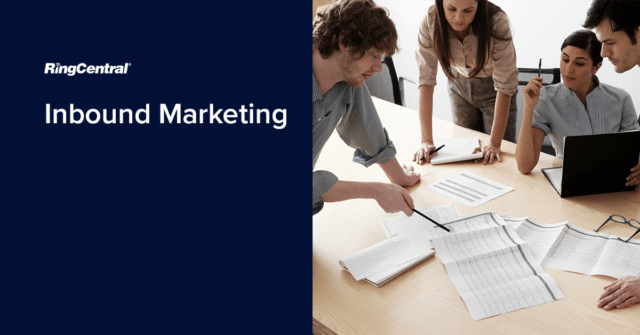With such intense competition, it’s increasingly difficult for businesses to get the attention of prospective customers. From the clever use of social media platforms to search engine optimisation (SEO), marketers go to great lengths to draw consumers in. As a result, they have to get more and more inventive in the marketing tools they use.
One technique that’s become increasingly central to marketing efforts is inbound marketing. In short, inbound marketing involves targeting potential new customers through various channels – including content marketing, social media, webinars, white papers and SEO – by providing quality content and experiences.
This guide will provide you with a detailed introduction to inbound marketing and how it works. First, we’ll provide a more in-depth explanation about what inbound marketing is and how it rose to prominence. Then we’ll look at the differences between inbound marketing and outbound marketing techniques.
We’ll also cover some of the most important benefits of inbound marketing to get a better idea of why so many businesses are using it before moving on to discuss some inbound marketing strategies and list some useful inbound marketing tools.
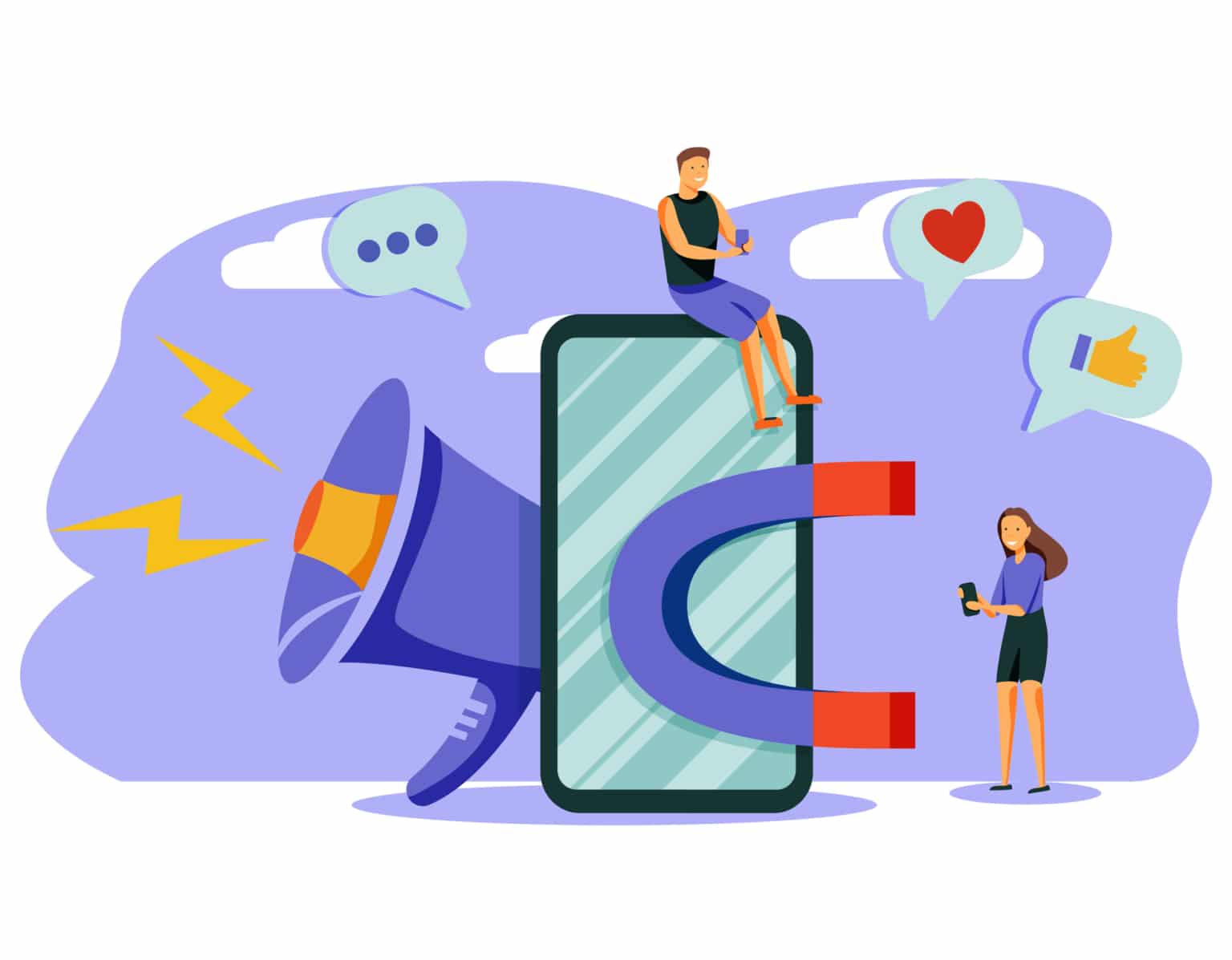
What is Inbound Marketing?
As we’ve just discussed, inbound marketing is a form of content marketing that aims to attract new visitors and convert them into customers by providing them with detailed, relevant content. Thus, inbound marketing campaigns aim to drive traffic, engagement and ultimately conversions by providing useful and engaging content.
Inbound marketing has been growing in popularity since Hubspot’s co-founder Brian Halligan first coined the term, and many firms swear by it. Advocates of inbound marketing strategies say that they help to boost lead generation through the provision of quality content. This way, customers get something they find genuinely useful and feel more encouraged to complete purchases. Inbound marketing thus helps to generate lasting goodwill.
There are, according to Hubspot, three main elements to the inbound marketing methodology:
- Attract: Draw visitors in with valuable and useful content which serves their purposes and also helps you build authority and credibility among consumers.
- Engage: Provide engaging insights and authoritative solutions relevant to the needs, concerns and desires of customers. This is more likely to result in an ultimate conversion.
- Delight: Offer customers the kind of support and assistance that’ll help them make the very most of their purchases.
The key, however, is to ensure that you provide relevant, high-quality content at each stage of a buyer’s journey. You need to understand what sort of content is likely to elicit the right sort of response from customers and thereby encourage them to take the next step in their journey. They’re also likely to share this kind of content with others.
So, when they’re first made aware of a particular problem, businesses might seek to supply content such as guides and opinion pieces from thought leaders, infographics, well-informed blogging and troubleshooting tips across a variety of different pain points.
Then, when they reach the stage of considering how to address the problem they’ve identified, consumers might benefit from webinars, podcasts, Q&As, expert blogs and ebooks. At the next stage, consumers have a clearer idea of what kind of solution they’re looking for. At this point, they want guidance on which solution to choose, so they’ll be looking for relevant case studies, demos, free trials and competitor comparisons.
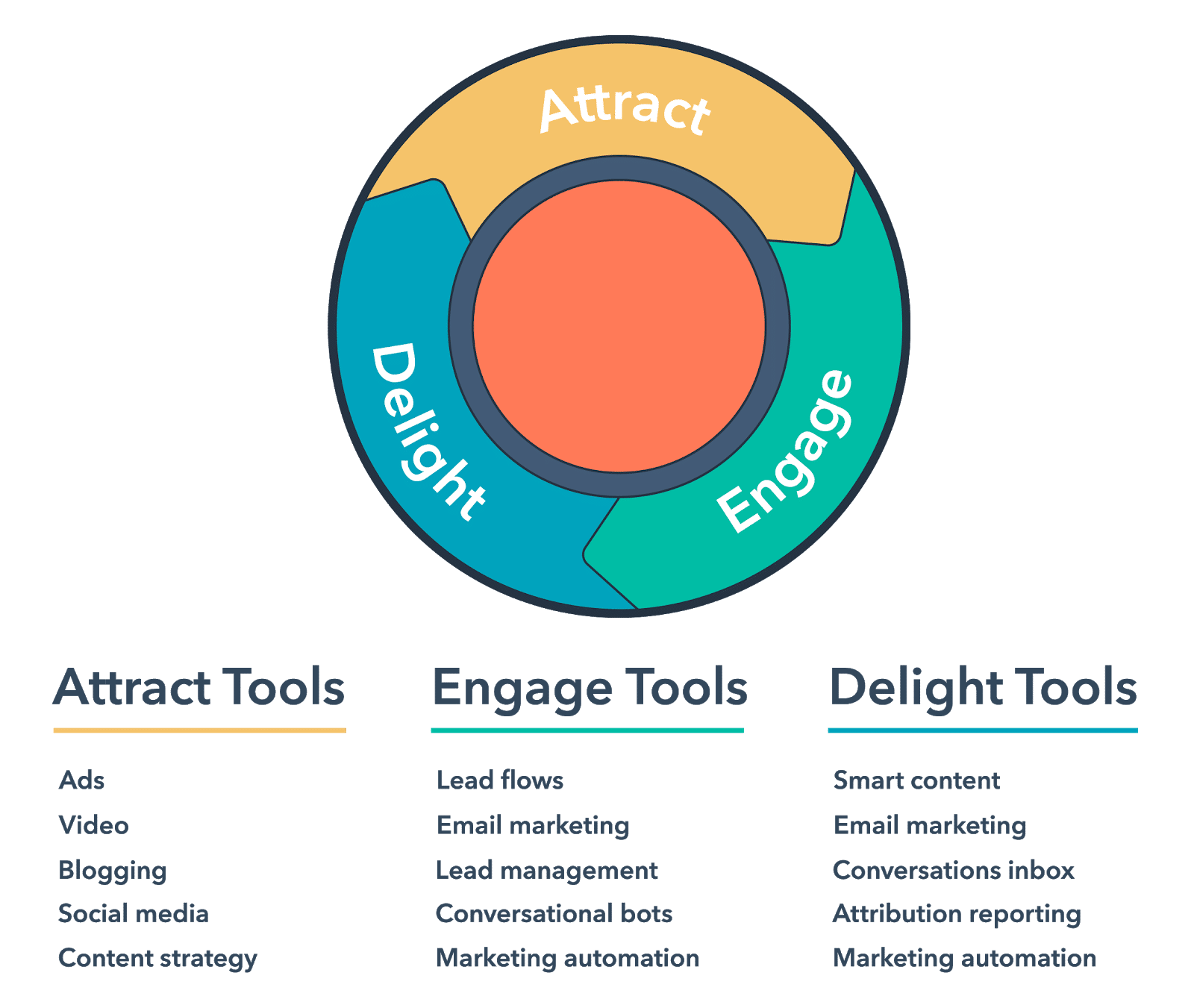
Your engagement with the customer shouldn’t stop the moment they complete a purchase either. Instead, you should continue to provide them with valuable information to maintain that goodwill and build a strong relationship. Follow-up emails and surveys are good ways of gaining information and laying the foundations for future transactions.
What’s more, you should ensure that your inbound marketing content (along with your landing pages) is well optimised for social media and SEO. Search engine results are crucial, and the higher your content is placed in search engine results in pages (SERPs), the more visible it’ll be to potential customers. Shareable and engaging content, meanwhile, is always likely to do well on social media.
Don’t forget the basics: a strong call to action (CTA), testimonials and contact information, for example, are important in helping potential customers find what they’re looking for and in guiding them to take further action that might lead to a purchase.
Inbound Marketing vs Outbound Marketing
To understand the basic difference between inbound marketing and outbound marketing, you save to look at their respective names. Inbound marketing is concerned with bringing would-be customers in, whereas outbound marketing aims to promote brands and products outwardly.
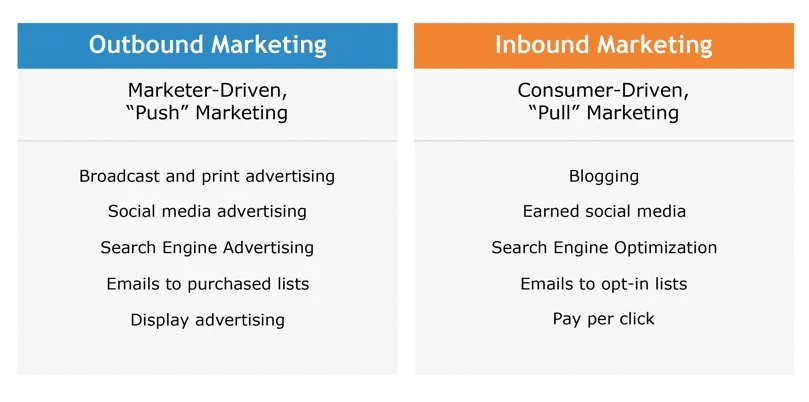
Outbound marketing tends to make greater use of paid media for promotional purposes. This includes traditional marketing methods like print and broadcast media and digital marketing strategies such as paid email marketing and display advertising. It may also involve social media marketing through sites like LinkedIn, Facebook and Twitter.
Inbound marketing, on the other hand, aims to expand organic reach through content creation and promotion. It can encompass the use of owned media (first-party outlets owned by businesses, including their websites and social media accounts) and earned media; this refers to third-party outlets both online and offline, ranging from print publications to online forums and organic social media reach.
Outbound marketing tends to be more intrusive in its techniques, which can include simple cold calling and letters. This is because it aims to put a business or brand and its products and services in front of as many people as possible. As a result, it is less concerned with providing consumers with useful content or fostering loyalties with them.
The trouble with this is that consumers tend to tune it out, peppered with advertising everywhere they look (radio, TV, newspapers, magazines, billboards, online). Worse still, it can even be counter-productive; many consumers have come to resent being besieged with marketing materials in this way.
By contrast, inbound marketing places great emphasis on creativity and the quality of the content involved. Rather than bombarding a target audience with propaganda, inbound marketing instead seeks to weave brand and product messaging into authoritative quality content that genuinely informs and helps the reader.
As we’ve already discussed, this helps to generate lasting goodwill on the part of the consumer. Again, this is because they’ve been provided with something over and above bog-standard marketing; they’ve helped resolve a problem by a business that offers relevant solutions. As a result, this is considerably more likely to elicit a positive response.

Benefits of Inbound Marketing
Now that we’ve outlined some of the crucial differences between inbound marketing and outbound marketing, we now need to move on and look at some of the most important benefits of the former. We’ve already touched on these in passing, but it’ll help if we examine them in greater detail here.
The most important is one we’ve just been discussing: goodwill. Consumers can be a cynical bunch at times, and with good reason. However, they’ve learned through experience that if something is too good to be true, then it probably is. So if they come across valuable content that really helps them deal with a particular problem (with no guarantee of a financial return in doing so), they’re likely to look at this very positively.
Put yourself in the consumer’s position: if you have a positive user experience with a particular business, you’d no doubt be a lot more inclined to purchase from them and to return to them in future. This is the kind of sentiment inbound marketing aims to generate, potentially leading to lasting customer loyalty.
It might sound like a rather convoluted form of lead nurturing, but it can deliver real results. Leads of this kind are known as qualified leads: in other words, people who could become customers having willingly provided information, rather than being reached via email lists or cold calling.
Following on from this point, inbound marketing tends to generate higher-quality traffic when compared to outbound marketing. Inbound marketing is intended to build organic reach, and it involves putting real thought into which consumers to target and where to find them.
This means that inbound marketing often provides better value for money than outbound marketing, as it’s more precisely and intelligently targeted. Often, outbound marketing budgets are largely wasted on people who aren’t likely ever to become paying customers. Inbound marketing, when done correctly, concentrates on more promising prospects.
Another important advantage of inbound marketing is that it reduces businesses’ reliance on individual channels. Rather than putting all your eggs in one basket – whether it happens to be social media referrals, organic search or links from other websites – you can adopt a broader approach and earn better traffic from more sources.
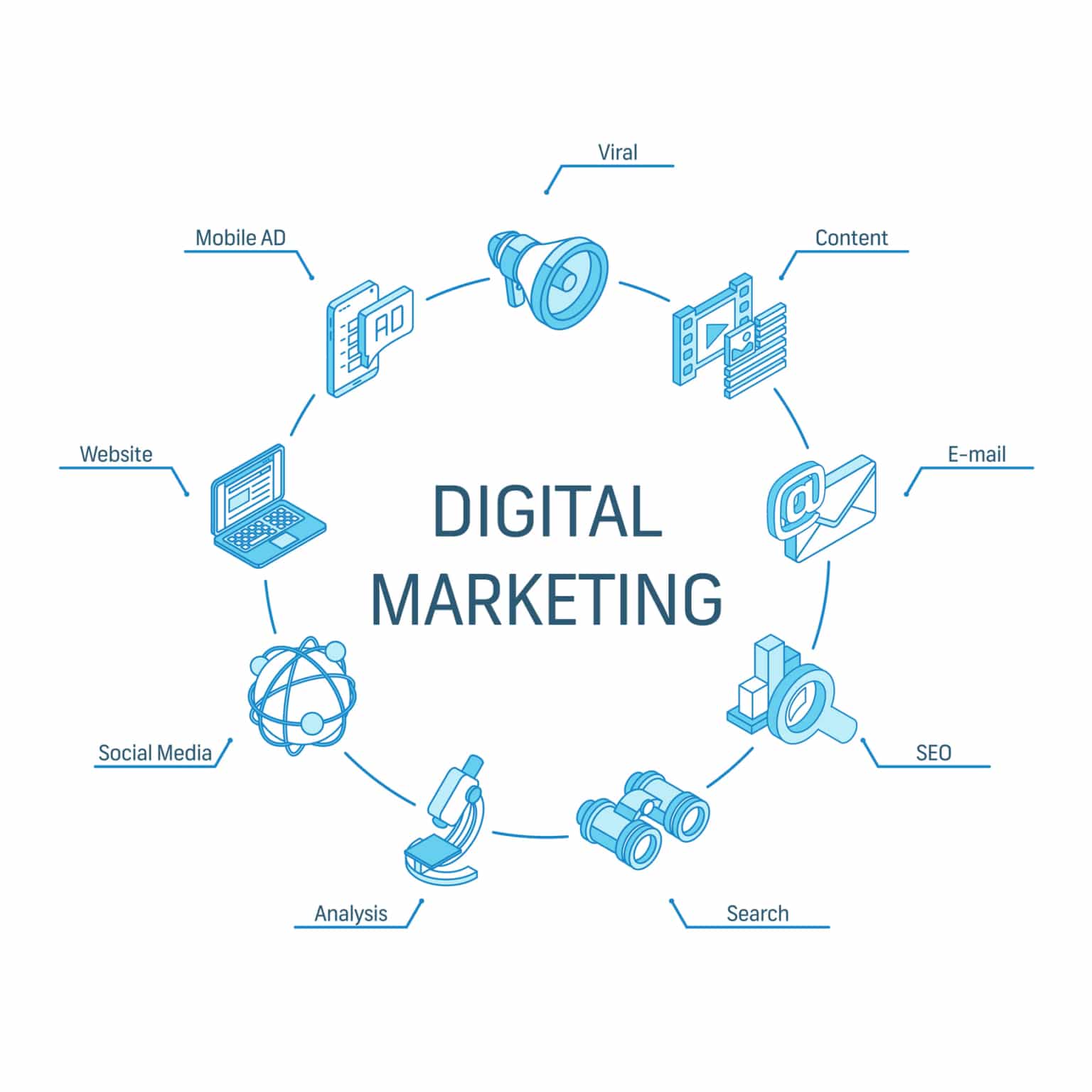
Inbound Marketing Strategies
IOf course, it’s very well talking about what inbound marketing can do for business – but unless you take a strategic approach to it, you won’t reap the full rewards. You can adopt various approaches to make the most of the inbound methodology; here, we’ll list some of the most important strategies.
Create buyer personas
First and foremost, it’s essential that you truly understand the people you’re going to be targeting. This is why it’s a good idea to create buyer personas, breaking down your target audience by various demographics (gender, age, location, income), preferences and other relevant characteristics.
When creating a buyer persona, you need to dig deep into the data at your disposal. For instance, you can get a quick overview of your customer base looks by checking the Insight tab on Facebook. This will give you an idea of who your page’s biggest fans are, by age and gender, thereby providing you with a good starting point.
Ask your customers
We mentioned follow-up emails earlier, and you can use these to send surveys to customers – a beneficial way of garnering actionable insights. You could also arrange to conduct short phone interviews with consumers. Then, if you’re struggling to get responses, you could make it worth their while by offering them a little bonus, such as an exclusive deal or discount voucher.
Content is king
The central pillar of your inbound marketing strategy, of course, is the content you produce. If you can consistently produce excellent content, you’ll attract new customers and give existing customers a reason to keep coming back to your website. A well-maintained, regularly updated on-site content hub can be a hugely useful resource.

Competitor analysis
It would be best if you undertook regular competitor analysis to see what your rivals are doing. This will help you get a better idea of how their offering stacks up against yours. For example, if a competitor’s content is excellent, you’ll need to reconsider yours accordingly. Alternatively, your rivals may have content gaps – relevant areas that they’ve neglected – presenting a potential opportunity for you to take advantage of.
Inbound Marketing Tools
Strategy matters a great deal to inbound marketing, but you also need the right tools. Inbound marketing tools can help you implement your strategy much more effectively and understand whether it delivers the desired results.
It’s not enough just to put content out into the public domain and hope it does the job. You must keep a watchful eye on how it performs. This involves using the appropriate metrics to measure its success (or otherwise). Analytics can provide you with detailed insights into how your content performs and highlight any room for improvement.
Google Analytics is widely used by businesses to track their SEO performance and other tools such as SEMRush. This way, you’ll be able to see which content performs best and which content is falling short of expectations.
The importance of marketing automation shouldn’t be overlooked. Tools like Hubspot can automate tasks like lead nurturing while providing detailed data on content performance. In addition, Hubspot CRM can help you manage customer relationships by tracking every interaction individual consumers have with your business and its website.
Automated marketing can also guide consumers along the sales funnel, saving your sales team the extra effort of personally reaching out to prospective leads. Instead, your sales team can concentrate on leads on the cusp of buying, while your CRM cultivates leads who are still at earlier stages of their buyer journey.
RingCentral for Retail is another great solution for creating excellent customer experiences. It allows you to talk to customers across every digital channel, all from one place. Better still, it provides agents with profile and purchases data from integrated CRM apps, allowing them to personalise their service. With accurate call routing, SMS alerts for click and collect, and delivery services, as well as top-tier security, it’s a must-have addition to your marketing suite.
Originally published Jun 17, 2021, updated Apr 10, 2023
